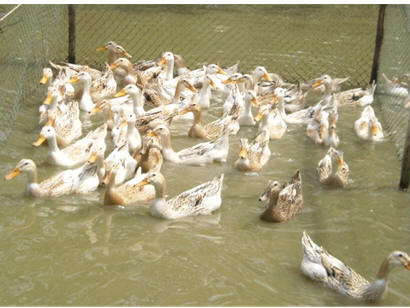 |
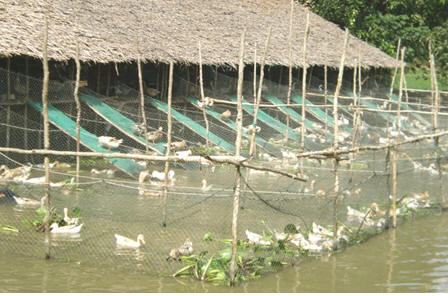 |
| Photo 1: The duck layers prepared for the trial | Photo 2: Housing for laying ducks of the trial |
| Back to contents |
An experiment was conducted on a small household farm of Cantho City on the crossbred Chinese ducks (laying type) to evaluate the effect of using fresh Tra fish by-products as protein supplements to replace for soybean meal in diets of the reproductive performance of laying ducks. The ducks in the experiment was kept in housing confinement with access to the water surface of a fish pond for swimming and with biosecure controls applied to the system.
A total of 180 laying ducks from 29-41 weeks of age were used for the trial. The ducks were randomly allocated into three treatment groups, with three replicates. The ducks in these treatments were supplied three diets contained 17% protein, but with different protein supplement sources. The experimental treatments were: (1) Laying ducks were fed a diet with protein supplement only from soybean meal as a control diet (TF00), (2) Laying ducks were fed a diet contained fresh Tra fish by-products as a replacement for 50% protein supplement from soybean meal (TF50), and (3) Laying ducks were fed a diet contained completely protein supplement from Tra fish by-product (TF100). All the ducks of these treatments were fed ad-libitum.
The results obtained from the experiment show that average daily feed intake (DM) were 141, 119 and 98.1 g/duck (P<0.001) and egg yields produced for a 12-week period of the trial were 64.8, 54.8 and 31.5 eggs/bird (P<0.001) for the TF00, TF50 and TF100, respectively.
Corresponding feed conversion ratios for every 10 eggs were 1.81, 1.8 and 2.59 (P<0.001). There were no significantly different on body weights, egg qualities between ducks fed with or without Tra fish by-product in diets. Use of Tra fish by-product as a replacement for 50% protein supplement of soybean meal in diets of laying ducks decreased feed costs up to 11% per egg.
Demand of duck eggs of the consumers are increasing by the eating habits for a long time of people of the country. The duck eggs can be processed into several different foods, such as omelet, boiled, salted, alkali and half incubated eggs. At present, the population of laying ducks occupies around 70% the duck total in the Delta. Duck eggs continue seen be as good foods with high consumption in the local markets, event higher than those chicken eggs in several areas. However, activities of the traditional duck production are faced with many problems. The main constraints affecting the free-grazing system today include the fact that the time available for the ducks to scavenge the fields between harvests has decreased, or been limited, because the land needs to be prepared as quickly as possible for new early-maturing, high-yielding rice varieties. The cost of transporting ducks from province to province for scavenging has increased because of the high price of gasoline. An additional factor has been the spread of AI disease in the year round with high risks for scavenging ducks, and the movement restrictions imposed by local governments as measures to control HPAI, which have tightened restrictions on duck flocks coming in from other provinces. On the other hand, the prices of animal feeds continuously increase because they depend on fluctuating feed prices of the world marketing, especially the commercial feeds for fish, pigs and poultry used in the intensive farming systems that cause the input too high to get benefits for poultry producers.
In recent years fish producers have been encouraged to increase Tra fish production for both for national consumption and export. Yield of the fish produced annually have been around over 1 million tons (plan for 2020 being 2 M tons) of which 70% accounted for by-products as an offal (heads, backbone, skin, fat and internal organs). So, a big amount of the by-product could be recycled as energy (for both animal feed and bio-fuel), protein and mineral sources for poultry nutrition to contribute to sustainable production of the region.
Because of climate changing, the earth warmer and sea water level higher have been warned that influence directly lives and agricultural production of people in the Delta. So, ducks, fish and water plants will be candidates to develop in a sustainable status, because they are living agents with low impacts on the greenhouse effect and with low difficulties if they are kept in the water environment rising and could be integrated production systems in the year round.
A study was carried out on an integrated laying duck – fish system of a farmer household to evaluate performances of laying ducks fed Tra fish by-products as replacements for protein supplements in diets from 29 to 41 weeks of age.
· To study effect of levels of Tra fish by-products in diets on reproductive performance of laying ducks.
· To evaluate efficiency of using Tra fish by-products to replace for imported soybean meal on economic effects.
· To introduce to farmers the idea of using local feed sources for sustainable poultry production.
The trial was conducted from May to August, 2010 on a small household farm at Phuoc Thoi sward, Omon district of Cantho City.
The ducks were randomly allocated into three treatments and with three replicates. The ducks in these treatments were supplied three diets contained 17% protein, but with different protein supplement sources. The experimental treatments were:
- TF00: Laying ducks were fed a diet with protein supplement from soybean meal as a control
- TF50: Laying ducks were fed fresh Tra fish by-products (TF) replacing 50% soybean meal protein
- TF100: Laying ducks were fed completely protein supplement from Tra fish by-products
All the ducks of these treatments were fed ad-libitum. Also, the ducks were supplemented water hyacinth (WH) plants in free choice to stimulate appetites and supplement vitamins, minerals and pigments. The plants were collected on the canal nearby the experimental site. Experimental animals were crossbred Chinese laying ducks started from 29 weeks of age and ended at 41 weeks old.
The housing for the trial ducks was built with a nylon net floor attached on bamboo frames over the fish pond 1 meter, and access to the pond water surface. The feeders, drinkers and nest boxes were fixed on the floor of each plot. The laying ducks were daily lighted total 18 hours with 3W/m2 at night. The ducks were vaccinated for duck plague and avian influenza diseases and eliminated parasitic worms. Also, the ducks were reinforced by vitamin C in drinking water when unfavourable weather.
 |
 |
| Photo 1: The duck layers prepared for the trial | Photo 2: Housing for laying ducks of the trial |
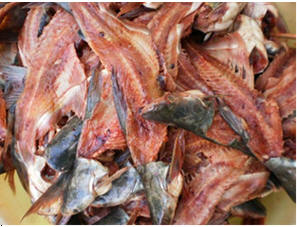 |
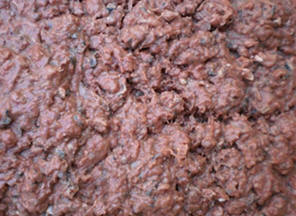 |
|
Photo 3: Fresh Tra fish by-products before and after grinding |
|
Fresh Tra fish by-products after purchasing were ground into small pieces for use as a supplement protein, then mixed with different levels with the mashes before feeding to the layers. Composition and nutrient of the feeds used for feeding experimental ducks are shown in table 1.
|
Table 1: Composition and nutrient values of the feed ingredients* |
|||||||||
|
Ingredient |
DM (%) |
ME (kcal/kg) |
% DM |
||||||
|
CP |
EE |
CF |
Lys. |
Met. |
Ca |
P |
|||
|
Maize |
88.0 |
3,319 |
9.27 |
3.06 |
3.10 |
0.31 |
0.18 |
0.40 |
0.38 |
|
Rice bran meal |
88.0 |
2,286 |
16.2 |
1.80 |
5.78 |
0.45 |
0.24 |
0.22 |
1.36 |
|
Rice grains |
88.2 |
2,786 |
7.82 |
1.54 |
11.8 |
0.34 |
0.16 |
0.20 |
0.31 |
|
Soybean meal |
87.7 |
2,817 |
51.0 |
1.74 |
3.61 |
3.21 |
0.66 |
0.44 |
0.83 |
|
Tra fish by-products |
43.6 |
2,030 |
27.8 |
53.8 |
1.45 |
1.06 |
0.37 |
4.58 |
2.74 |
|
Bone meal |
95.3 |
1,035 |
22.3 |
5.27 |
1.81 |
0 |
0 |
19.4 |
6.68 |
|
Water hyacinth |
10.4 |
195 |
14.2 |
1.53 |
22.8 |
0.65 |
0.26 |
1.72 |
0.39 |
|
*Samples were analysed at the laboratories of Cantho University |
|||||||||
|
Table 2: Composition and nutrient values of experimental diets |
|||||
|
Composition, % |
TF00 |
TF50 |
TF100 |
||
|
Maize |
42.8 |
20.5 |
5.86 |
||
|
Rice bran meal |
8.48 |
14.9 |
19.2 |
||
|
Rice grains |
14.0 |
12.0 |
10.0 |
||
|
Soybean meal |
23.8 |
9.75 |
0 |
||
|
Tra fish by-products |
0 |
36.0 |
60.9 |
||
|
Bone meal |
3.50 |
2.86 |
2.42 |
||
|
Oyster meal |
6.42 |
3.33 |
0.95 |
||
|
Dicalciphosphate |
0.39 |
0 |
0 |
||
|
L-Lysine HCL |
0.03 |
0.16 |
0.26 |
||
|
DL-Methionine |
0.1 |
0.1 |
0.08 |
||
|
Premix |
0.20 |
0.16 |
0.14 |
||
|
Salt |
0.30 |
0.25 |
0.21 |
||
|
Dietary nutrients ( 88% DM) |
|||||
|
ME, kcal/kg |
2700 |
2910 |
3125 |
||
|
Protein, % |
17.0 |
17.0 |
17.0 |
||
|
Ether extract, % |
2.01 |
11.8 |
21.6 |
||
|
Crude fiber, % |
3.86 |
3.84 |
3.75 |
||
|
Lysine, % |
0.88 |
0.88 |
0.88 |
||
|
Methionine, % |
0.35 |
0.35 |
0.35 |
||
|
Ca, % |
2.90 |
2.90 |
2.90 |
||
|
Pava., % |
0.43 |
0.51 |
0.66 |
||
Daily temperature and relative humidity data inside the duck house were measured and recorded. Feeds daily offered and refused were recorded and weighed to measure daily feed intake. Representative samples of feeds were collected for chemical analysis. The live weight was taken at the beginning of the study and the end of the trial. Egg yields were collected every day.
Chemical analyses of feeds were performed according to AOAC (1990). Crude protein (N x 6.25) were analysed by the marcro-Kjeldahl method and ether extract by Soxhlet. Calcium was analysed by using fluorexone (TCVN 1526-86). Phosphorus was analysed by the Vando-Mollybdat method (TCVN 1525-86). Amino acids were analysed by the liquid chromatography mass spectrometry (EZ-LCMS).
Metabolizable energy (ME) content of all the diets were calculated from chemical analysis data using the equation of Nehring and Haenlein (1973) and conductions of NIAH (2008).
Data were analysed by analysis of variance using the General Linear Models procedure of Minitab, Version 13.2 (Minitab, 2000).
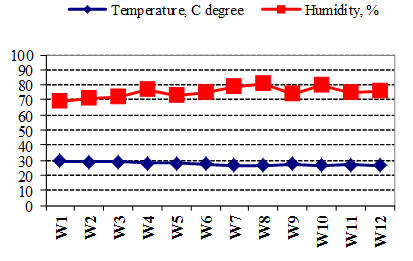 |
| Figure 1: Temperatures and relative humidities measured in ducks’ housing |
However, fluctuations of the temperatures in the day rather high, especially in the afternoon, sometimes the temperature increased up to 35 oC. Living in the high temperatures the reproductive performances of poultry such as health state, egg sizes and thick shell eggs decreased and broken eggs increased (Yahav et al 2000 and Roberts 2004).
Daily feed intakes of the experimental ducks are shown in Table 3 and Figure 2.
|
Table 3: Daily feed intakes of the experimental laying ducks |
|||||
|
Parameter |
Treatment |
SEM |
P |
||
|
TF00 |
TF50 |
TF100 |
|||
|
Mash intake, g/duck |
156.4a |
143.6ab |
134.9b |
4.43 |
0.037 |
|
DM of mash, g/duck |
138.2a |
113.0b |
93.2 c |
3.57 |
0.001 |
|
WH intake, g/duck |
24.5a |
53.8b |
47.1b |
4.68 |
0.010 |
|
DM from WH |
2.5a |
5.6b |
4.9b |
0.49 |
0,010 |
|
Total feed intakes as fed |
180.9 |
197.4 |
182.0 |
4.89 |
0.095 |
|
Total intakes in DM |
140.7a |
118.6b |
98.1c |
3.41 |
0.001 |
|
a, b, c mean without common superscripts within rows are significantly different (P<0.05) |
|||||
Data from table 3 show that total feed intakes as fed of the layers are fluctuant among the treatments, but there is a tendency for treatment TF50 to be greater than treatments TF00 and TF100 (P=0.095). Total daily DM intakes of the ducks in the TF100 is lowest, only around 69% when compared with the control (TF00) treatment (P<0.001).
Daily fresh WH intakes of the ducks in the control diets was the lowest, but there is no difference between the ducks fed Tra fish by-products replaced for 50 or 100 protein supplements from soybean meal in the experimental diets.
 |
| Figure 2: Daily feed intakes of the duck layers |
Based on the total feed intakes of the ducks, data of nutrient intakes of the ducks were calculated and shown in table 4 bellow:
|
Table 4: Daily nutrient intakes of the duck layers |
|||||
|
Parameter |
Treatment |
SEM |
P |
||
|
TF00 |
TF50 |
TF100 |
|||
|
ME, kcal/duck |
428.7a |
384.2ab |
340.0b |
11.20 |
0.004 |
|
Crude protein, g/duck |
27.1a |
22.6b |
18.7c |
0.67 |
0.001 |
|
Lysine, g/duck |
1.4a |
1.2b |
1.0c |
0.04 |
0.001 |
|
Methionine, g/duck |
0.6a |
0.5b |
0.4c |
0.01 |
0.008 |
|
Crude fat, g/duck |
3.2a |
15.2b |
22.9c |
0.44 |
0.001 |
|
Calcium, g/duck |
4.6a |
3.8b |
3.2c |
0.12 |
0.001 |
|
Total phosphorus, g/duck |
1.2a |
1.5b |
1.8c |
0.04 |
0.001 |
|
a, b, c mean without common superscripts within rows are significantly different (P<0.05) |
|||||
 |
|
Figure 3: Daily protein and fat intakes of the duck layers
|
Data from table 3 and 4 show that the average crude fat intake of duck layers in the TF100 treatment is rather high, 22.9 g in total DM feed intake of 91.8 g when the ducks fed the diet contained 21.6% ether extract (table 2). The level of fat in the diet TF100 can be seen being too high and could decreased feed intakes of the layers. This fat level is higher than that suggested by Leeson and Summers (1997) that only around 8% fat supplemented in diets for commercial poultry.
Data shown in table 5 are results on live weights, egg yields and feed conversion ratios of the experimental duck layers fed with or without Tra fish by-products as protein supplements in diets.
|
Table 5: Egg yields and feed conversion ratios |
|||||
|
Parameter |
Treatment |
SEM |
P |
||
|
TF00 |
TF50 |
TF100 |
|||
|
Layer weights at 41 weeks of age, g/duck |
1192 |
1169 |
1163 |
21.8 |
0.628 |
|
Total production per layer, egg |
64.8a |
54.8b |
31.5c |
1.78 |
0,001 |
|
Daily production per layer, egg |
0.8 |
0.7b |
0.4c |
0.02 |
0.001 |
|
Laying rate, % |
78.1a |
66.0b |
37.9c |
2.13 |
0.001 |
|
Total egg yields, g/duck |
3,838a |
3,047b |
1,706c |
59.60 |
0.001 |
|
FCR, kg of DM/10 eggs |
1.8a |
1.8a |
2.6b |
0.06 |
0.001 |
|
FCR, kg of DM/kg of eggs |
3.0a |
3.23a |
4.8b |
0.07 |
0.001 |
|
a, b, c mean without common superscripts within rows are significantly different (P<0.05) |
|||||
From many tests done on qualitative parameters of the experimental duck eggs, the results of the tests are shown in table 6 below.
|
Table 6: Egg quality of the experimental duck layers |
|||||
|
Parameter |
Treatment |
SEM |
P |
||
|
TF00 |
TF5036 |
TF100 |
|||
|
Egg weight, g/egg |
59.2 |
55.7 |
54.4 |
1.14 |
0.057 |
|
Shell thick, mm |
0.39a |
0.35b |
0.33b |
0.01 |
0.003 |
|
Yolk color, level on color fan |
6.4 |
7.0 |
5.5 |
0.43 |
0.116 |
|
Haugh unit |
89.5 |
90.2 |
91.8 |
1.79 |
0.669 |
|
Egg white rate, % |
57.9 |
57.7 |
56.1 |
0.51 |
0.088 |
|
Egg yolk rate, % |
30.6a |
32.0ab |
33.8b |
0.70 |
0.048 |
|
White/yolk, % |
1.9 |
1.8 |
1.7 |
0.05 |
0.071 |
|
Egg shell rate, % |
11.4 |
10.3 |
10.1 |
0.33 |
0.052 |
|
a, b mean without common superscripts within rows are significantly different (P<0.05) |
|||||
Data in the table 6 show that the egg yolk rate is the highest in the eggs laid by the layers fed the diets with 100% protein supplements from fresh Tra fish by-products. The effect of fat intake levels on egg yolk rates are shown by the following regression equation:
Y = 29.95 + 0.158*X with R2 = 0.96 (see figure 4 below).
Where Y = egg yolk rate, % and X = fat intake, g/duck layer/day
|
Figure 4: Effect of daily fat intake on egg yolk rates of egg laying ducks |
Data in table 7 show that feed costs among treatments of the layers fed diets with or without Tra fish by-products as protein supplements to replace for soybean meal.
| Table 7: Effect of diet on feed cost* per egg | |||
| TF00 | TF50 | T100 | |
| Feed price, VND/kg | 6,896 | 5,656 | 4,967 |
| Feed costs, VND/duck/day | 1,078 | 812 | 670 |
| Feed costs, VND/egg | 1,381 | 1,231 | 1,768 |
| Ratio, % | 100 | 89.1 | 128 |
| * Based on market price per kg for maize 6,200, rice bran meal 4,725, rice grain 4,000, SBM 11,000, Tra fish by-products 5,000, bone meal 4,700, oyster meal 1,500, DCP 25,000, premix vit. 69,000, methionine 130,000, lysine 55,000 and salt 2,500 VND; 20,000 VND=1US$. | |||
From the results obtained in the trial there are some conclusions as follows:
Use of large amounts of Tra fish by-products replacing protein supplements with levels over 50% of the replacements increased the dietary fat and decreased feed intakes and resulted decreased egg production of crossbred laying ducks.
There were no significantly different on egg production of the use of 50% protein from Tra fish by-products in diets to replace for soybean meal, but reduced feed costs up to 11% per egg for the replacement.
There were no significantly different on body weights, egg qualities between ducks fed with or without Tra fish by-product in diets.
AOAC 1990 Official Methods of Analysis, 15th edition. AOAC Inc., Washington DC.
Leeson S and Summers J D 1997 Commercial Poultry Nutrition. 355p.
Nehring K and Haenlein G F W 1973 Feed evaluation and ration calculations based on net energy. Journal of animal science 36, 949-964.
NIAH, National Institute Animal Husbandry 2008 Composition and nutritive value of animal feeds in Vietnam. Agriculture Publishing House, Hanoi, Vietnam.
Minitab Reference Manual 2000 Release 13.2 for Windows. Mintab Inc. USA.
Roberts J R 2004 Factors affecting egg internal quality and egg shell quality in laying hen. Journal of Poultry Science 41, pp. 161-177.
Yahav S, Shinder D, Razpakovski V, Rusal M and Bar A 2000 Lack of response of laying hens to relative humidity at high ambient temperture. British poultry science 41, pp. 660-663.